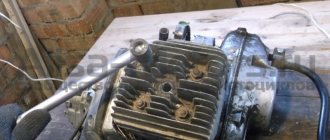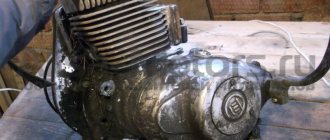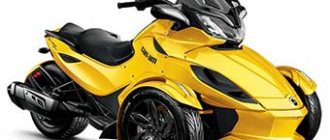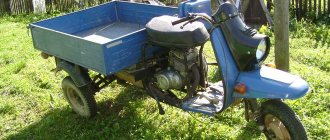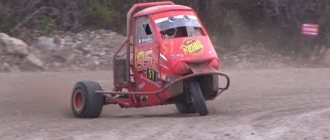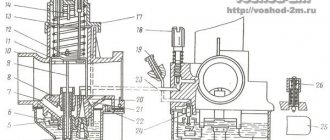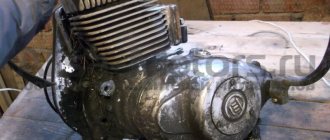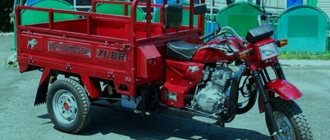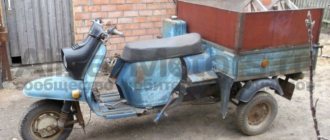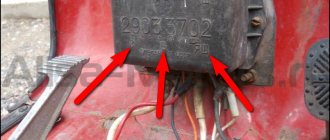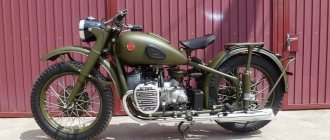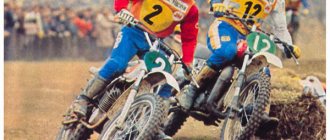The Ant cargo scooter began production back in 1959, and lasted on the assembly line for decades until it was finally discontinued. But the niche of “working” motorcycles even now remains practically vacant, and even attempts by Chinese companies to get into it do not bring much success, so the legendary model may have been officially revived. At least, rumors about this have been circulating online since 2021. And in 2021, the public was even shown a mini-truck assembled at the Tula plant and in the future intended to replace the famous old man.
Specifications
The outdated design was good for its time, although these days it looks like a kind of fossil even against the backdrop of more modern budget analogues from China. Despite this, the technical characteristics of the Ant scooter are good enough for the tricycle to cope with the tasks assigned to it.
Engine
The power unit with forced air cooling produces 11 horsepower , volume – 199 cubic meters . This is not enough, given the weight of the moped itself, so the maximum speed without load does not exceed 60 km/h , and with it it is even less, but from a safety point of view this is even good. The engine is not at all demanding on the quality of gasoline. Fuel is supplied to the combustion chambers by gravity, using a simple carburetor - there is no pump provided.
Transmission
The gearbox has 4 stages . You will have to work actively with the transmission, and it will also take some time to get used to its features - the gears are shifted roughly and harshly. At the same time, the gearbox is phenomenally reliable.
Chassis and brakes
This entire structure is placed on a steel tubular frame , and it is sprung using a complex suspension. At the rear there are shock absorbers similar to automobile ones (independent suspension, on wishbones), at the front there is a long-link fork. “Drums” on all wheels are responsible for braking.
Electronics
For decades, 6-volt batteries have been installed, two at a time, connected in series. Owners often install one 12-volt battery - according to reviews, this scheme works no worse. Although the user manual recommends that when using 12-volt batteries, it is also recommended to use two at once, connected in parallel. By the way, some people install a regular car battery, and place it directly in the body.
Weight and dimensions
The weight of the Ant motorcycle reaches 258 kg for modifications with an open platform , and 285 kg for versions with a closed body a la “van”. This is a lot, considering the weak motor, so the maximum speed that this miracle of technology can develop is small. But for utilitarian purposes it is more than enough. The length of the model reaches 288 cm, and the wheelbase is 184 cm.
Controllability
The maneuverability of Ant's scooter is surprisingly good, especially considering that this is still a vehicle for work, not for pleasure. It can turn around almost anywhere, which is very useful when maneuvering in a summer cottage or when parking in a garage. If it also had reverse gear, it wouldn’t have any value at all.
Fuel consumption
The declared fuel consumption reaches 4.5 liters per 100 km . The figure is not small, but it is partly due to the archaic motor of the mid-last century, and partly to the large mass that this motor has to drag. With a fully loaded platform, consumption can increase even more. But you can fill in absolutely any gasoline! The tank capacity is small - 10 liters .
A few words about the trailer
You can also make a trike yourself. The spaciousness of the body is indicated by the photo of the Ant scooter. A standard trailer consists of:
- stroller frame;
- L-shaped steel bracket;
- two clamps;
- tubular struts.
When working on the trike, it is very important to ensure that the trailer shell does not come into contact with the bracket. To increase the rigidity of the body, a steel gusset can be welded. In addition, it is important to make a homemade trike with an opening and removable tailgate. The sides and bottom are covered with boards. Additionally, the trailer is equipped with lighting equipment (dimensions, brake lights, turn signals).
Scooter price
Despite the fact that the USSR produced a huge number of copies of this tireless worker, it is not found on the secondary market as often as one might expect - apparently, no one is in a hurry to part with this valuable household assistant. On average, these mopeds are sold for 30-35 thousand rubles , and this is a very fair price for them.
Repair and tuning
Repairing and servicing the Ant motorcycle is not difficult, and besides, it is not necessary to do it often - the mileage of this specific motorcycle is short. But, if you often load it to the limit, you should pay special attention to the suspension elements, which in this case are subject to extreme loads.
Repair
You can probably repair a breakdown of any complexity yourself if you have at least once held a screwdriver and wrench in your hands. There is no point in dragging your property to a service center if you don’t have extra money. And the Internet is full of information about all common problems and ways to fix them.
Spare parts
Despite the fact that the tricycle has been out of production for a long time, there are no problems with spare parts. There are both used original parts and new non-original parts on sale, and both are inexpensive.
Tuning
No one deals with cosmetic improvements to utilitarian equipment, so all tuning almost always comes down to minor technical improvements, such as installing a more economical carburetor. But most owners are not even bothered by this, because standard parts already work satisfactorily. Tuning for an ant scooter is usually done only when the original unit has failed, and it is easier to replace it with a non-original one than to repair it.
Appearance
The design of the Ant scooter can be described as simple and unprepossessing. It doesn’t take long to look for reasons in this approach to developing the appearance. This was due to the times when it was developed, as well as its functional purpose.
The USSR was still going through difficult post-war times. Therefore, there was no need or desire to think about original design and any unique solutions. And in general, at the end of the 50s of the last century, domestic manufacturers and developers did not even use such a concept as “design”.
That is, it is completely unfair to blame Ant for looking simple and unsightly. This was due to the situation at that time. In addition, we are talking about agricultural machinery here. And a priori it is impossible to make demands on it for an attractive design.
But now the view on Ant has seriously changed. Against the backdrop of sophisticated technology and motorcycles, the Soviet scooter looks unusual, distinctive and original.
The lineup
Ant is rather a general name for a number of three-wheeled cargo scooters. Although many modifications had their own names.
In short, the model range consisted of the following scooters:
- TG200 (called Tula, at that time the name Ant was not yet used);
- TGA-200;
- TGA-200-01 (aka Tourist);
- TGA-200 01P;
- Ant-2 01 (Tulitsa);
- Ant-2 02 (Tulitsa-2);
- Ant-2 03 (was the last model as of 1991);
- GTS-1.
But most people are accustomed to the concept of Ant. Easy to remember and also sounds original.
Scooter modifications
The only modification is TG200, also known as T-200. There were other models, for example, “Tourist” and “Tulitsa”, also known as Ant 2, or Ant 2M 01. But all of them were ordinary two-wheeled vehicles, and not utilitarian motor vehicles. Therefore, they have the most indirect relation to the hero of our article, only in terms of compatibility for some spare parts. The TMZ version, equipped with a diesel engine instead of a gasoline engine, stands somewhat apart, but this is extremely rare these days. In museums you can also see a version with a cabin - such machines were used by the Soviet postal service in some regions.
A short summary
So, the Ant moped is a real Soviet classic . At the time of release, this vehicle was one of the best options in terms of price/quality. And now such a bike demonstrates good technical parameters. But, since the motorcycle has not been modernized for a long time, its fuel consumption is very high.
Thus, maintaining such a workhorse will cost a lot of money, so the bike is more suitable for lovers of rare models than for people who are looking for transport for daily use.
Video review of the Ant scooter:
Advantages and disadvantages
The few weaknesses are more than offset by numerous advantages. Simple and in some ways even primitive, this three-wheeled workaholic is capable of doing a huge amount of work with minimal effort. And only for this alone can he be forgiven for his imperfections.
Advantages
- Incredible endurance . For many owners, with proper attention and maintenance, it works for decades without any serious breakdowns.
- High load capacity . You can easily carry a third of a ton at a time.
- Good cross-country ability . Rough terrain is quite tough for him, even with a load.
- Economical . This is important for regular use.
Flaws
- The advanced age of all surviving specimens, which inevitably leads to various breakdowns from time to time.
- Exhaust and engine volume . To put it simply, it makes a lot of noise and on long journeys it is very annoying.
- Periodically arising problems with the brake system of the rear wheels.
Owner reviews
This one is in the garage; it is unknown when it was released; the documents were lost a hundred years ago. Grandfather drove it, dad too, now I drive it in the summer, when my mother-in-law is pottering around in the garden, and she needs to bring manure, hay, or something else. This fiend of Soviet industry is already 30-40 years old, apparently, but it is still rolling around, and in my memory it has never been seriously repaired at all! The mileage, of course, is ridiculous, God forbid 1000 km per season, but I rarely drive empty, I mostly carry junk, and probably with an excess, because... I never actually measured it, of course. This thing, it seems to me, will even survive the third world war. Ivan, Borisoglebsk.
A truly indispensable household assistant, it’s a pity they don’t make new ones like this anymore. In fact, you can load as much as you want, so much that it simply won’t fit in the body to break something, although the overall dimensions of the platform allow you to load a lot or more. You can see from the photo, although overall the dimensions are small, it easily fits into a Soviet garage on the side of the car. Vasily, Kirov.
Absolutely indestructible pepelats, starts even in winter, turning radius is surprisingly modest. One of the downsides is that it is sometimes difficult to get along dirt roads, since the front wheel does not go along the ruts, but between them. In general, you can find fault with a lot of little things, but for the time when it was released, I think it has no shortcomings. Alexey, Bologoe.
First meeting
The Ant is positioned as a cargo scooter created by the Tula Machine-Building Plant (TMZ) specifically for the needs and requirements of rural residents.
Production of Ant began in 1959. Taking into account the changes in modifications and versions, which many consider to be separate types of scooters, the equipment lasted on the assembly line for several decades. It was not until 1995 that production officially ceased.
It is also interesting that the segment of cargo motorcycles is still practically free. There are no serious competitors or any different options. This allows the Soviet Ant to still remain in demand and relevant, despite 2021 coming to an end.
It is also worth noting that in 2021 the question arose about the need to revive the production of cargo scooters at the facilities of the Tula plant. And in 2021 they even assembled the first prototype.
2021 has become a significant year. It was then that in the spring they launched the sale of the VTS-01 motorized trolley, equipped with a diesel generator power plant, as well as the VTS-02, but with a drive powered by a battery. Such a vehicle will cost at least 1.25 million rubles, which cannot but raise certain questions and sometimes bewilderment in the eyes of potential buyers.
If we talk about Ant, then this scooter became popular during the times of the USSR. At one time, it was practically the only three-wheeled truck that could be purchased for so little money.
In rural areas, it is perfect for small work and cargo transportation. The Ant gained its popularity due to its fairly solid load-carrying capacity, reliability, simplicity of design, maneuverability and the ability to carry out repairs with your own hands literally in the field.
This is a tricycle that still has an impressive army of fans. Many owners note that even modern Chinese analogues cannot compare with the advantages and capabilities that the good old Soviet Ant provides.
Similar models
- LIFAN LF200ZH-3 . An inexpensive hard worker originally from China, with a 200 cc engine, torquey enough to haul a significant weight.
- ABM Helper 250 . Another native of China, quite tenacious, reliable and unpretentious.
- Triton 200 . A not very common model in Russia from ZIP Motors, in many ways similar to the two aforementioned competitors.
FAQ
- What is its maximum load capacity? You can put 340-375 kg on the platform depending on the year of manufacture (there are minor differences), but you should do this carefully so as not to tip over on your side somewhere in a turn.
- What about the maximum speed with and without a load? Without it - 60 km/h, according to the manufacturer. With a load, it is better to drive slowly and carefully, since a loaded tricycle is controlled in a very non-trivial way and is not stable.
- They haven't been produced for a hundred years now, I'm afraid I can't find spare parts. Are there any Chinese analogues? No, there are no direct analogues, but in most cases you can choose something suitable and then modify the part with a file. And in general there are enough non-original Russian-made spare parts.
What category of rights is needed for the owner of Ant?
Also, many people are interested in the question of what category of license will be needed for the Soviet Ant scooter.
Here it is even more logical to ask whether rights are needed at all. If the Ant scooter will be used exclusively as an assistant in the garden or summer cottage, without going on public roads, then, in principle, you can do without a license.
It would not be superfluous to figure out which of the existing categories of rights actually applies to today’s hero scooter Ant.
Taking this into account, you will eventually understand what category of license is needed and whether you will have to separately obtain a category for your driver’s license in order to be able to ride the three-wheeled Soviet motor scooter Ant.
According to the generally accepted classification that operates in the Russian Federation, a motor scooter belongs to the category of tricycles. As of November 2013, category B1 is required to drive tricycles and quads. To be more precise, it is considered a subcategory.
If you have category B rights of the old type, when exchanging for a new type of certificate, the corresponding category is automatically included in the document. In this situation, you will not have to take courses and pass your license.
But it happens that the owners of Ant themselves modernize the equipment. Depending on the changes made, the situation with rights and the required category may change.
If it is a lightweight design and the weight of the equipment does not exceed 400 kilograms, and the power is up to 20 horsepower, then it is quite possible to get by with category A.
If the weight exceeds 400 kg, even in conditions of lightweight characteristics there is no way to do without category B1.
If the engine volume exceeds 50 cubic centimeters, you will have to open the M subcategory in your license.
Now look at your current license and see if your license option is suitable for legally driving a Soviet scooter.
Conclusion
During the Soviet era, the Tula plant managed to produce many hundreds of thousands of copies of this incredibly popular equipment. Thanks to their successful layout, they enjoyed unprecedented popularity, since they were, in fact, the only affordable freight transport. Therefore, even now in villages and hamlets across the vast expanses of our vast country, the Ant moped remains in demand. It is repaired on the knee, stored in a barn, and at the same time regularly carries substantial loads, costing a very modest amount of maintenance. And even the gradual penetration of cargo trikes from China into the Russian market failed to shake its popularity.
Specifications
| Maximum engine power: | 11 l. With. at 4600 rpm HP |
| Torque: | 16.3 Nm at 4900 rpm Nm |
| Working volume: | 199 cm3 |
| Motor type (cylinder arrangement, number of strokes): | Single-cylinder, carburetor, two-stroke with forced air cooling |
| Number of cylinders: | 1 |
| Number of valves: | |
| Intake type (Injector / Carburetor): | |
| Bore and stroke: | |
| Starting system (Electric starter, kick starter): | |
| Maximum speed in km/h: | 60 km/h |
| Cooling system: | Air |
| Transmission (gearbox): | 4-speed, reverse gear (reverse gear) |
| Clutch (Dry / Wet): | |
| Drive unit: | Cardan |
| Frame: | Steel tubular |
| Chassis | |
| Suspension (front/rear travel): | |
| Brakes (Front/Rear): | |
| Wheels / Tires / Rubber: | |
| Dimensions and weight | |
| Dimensions (Length / Width): | |
| Seat height: | |
| Ground clearance: | |
| Curb weight: | |
| Wheelbase: | 1840 mm |
| Weight: | 258 kg |
| Fuel tank capacity: | 10 l. |
| Battery capacity: | |
| Year of release: | |
| Country of Origin: |
